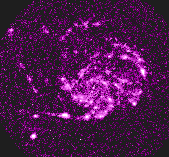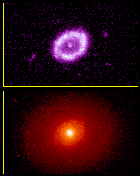 Further information can be found on the
UIT home page.
Further information can be found on the
UIT home page.



Looking at the night sky, we can see a variety of celestial objects: the Moon, Venus, and Mars, stars of different colors, and even distant galaxies. But the light that passes through the filter of Earth's atmosphere is only a small part of the radiant spectrum being emitted or reflected by each object. This narrow portion is even further reduced by the human eye, which sees best in the middle of the visible spectrum. Until the space age, astronomers were limited in their efforts to understand the universe to the information carried in this highly filtered signal.
The wavelengths to either side of the visible spectrum contain a wealth of important information about the cosmos. While the human eye cannot see such energy, electronic cameras and special film can be produced that "see" wavelengths the eye cannot and can convert them into an image that we can behold. Such photographs reveal much that is hidden from "normal" sight, allowing astronomers to view the universe in a whole new light.
Images made in the ultraviolet spectrum clearly show the dynamic events taking place beyond our world. Hot stars leap into prominence, the spiral arms of distant galaxies snap into clearer resolution, and the material hidden between the stars comes into view. Each range of energy, such as near and far-ultraviolet, reveals previously hidden details of our universe.
Ultraviolet imaging is an important part of modern astronomy and is possible only because of space flight. Only by going above the obscuring veil of Earth's atmosphere can scientists obtain such images. The Ultraviolet Imaging Telescope was designed and built to answer the need for high-quality, wide-field ultraviolet images of the cosmos. Such images are the primary means of discovering fundamental phenomena and determining how well-known objects look in ultraviolet light.
During the Astro-1 mission, the Ultraviolet Imaging Telescope obtained a large number of images, including clusters of young, hot massive stars; globular clusters containing old stars, some of which are unusually hot; spiral galaxies rich with star forming activity; and smaller "irregular" galaxies that can experience sudden bursts of star formation. Such images provide a wealth of information to astronomers, and the images obtained during the Astro-2 mission will continue the important work of imaging the ultraviolet sky.
A Technical Summary of UIT gives more scientific details of UIT's capabilities.
 Further information can be found on the
UIT home page.
Further information can be found on the
UIT home page.
Portions of this text were taken from the NASA pamphlet ASTRO-2: Continuing Exploration of the Invisible Universe produced in September 1994.